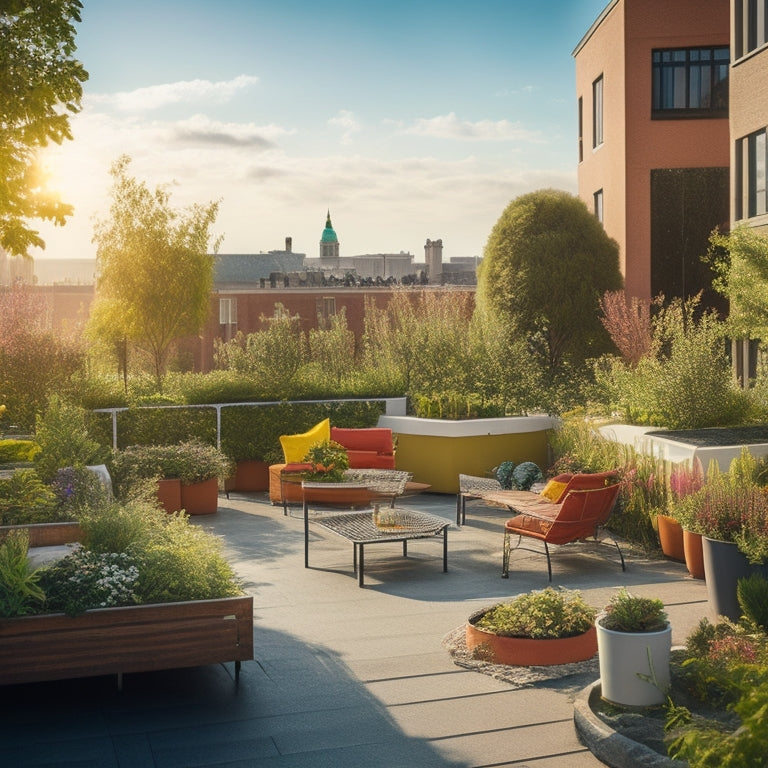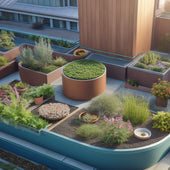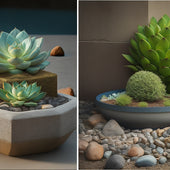
Rooftop Gardening Inspiration for Educational Institutions
Share
You can revolutionize education by repurposing rooftops into interactive learning labs that promote sustainability, wellness, and hands-on learning experiences. By incorporating edible gardens, green spaces, and innovative outdoor classroom designs, you'll create hubs for community engagement, interdisciplinary collaboration, and environmental issue discussions. Your students will benefit from tranquil escapes, nutrition education, and biodiversity exploration. As you design your rooftop garden, consider modular seating, vertical gardens, and rainwater harvesting to maximize space and learning opportunities. With a little creativity, your institution's rooftop can become a vibrant outdoor classroom that sparks new discoveries and inspires a deeper connection with nature and sustainability, and there's even more to explore.
Key Takeaways
• Rooftop gardens can transform into interactive outdoor classrooms, enhancing hands-on learning and interdisciplinary collaboration in educational institutions.
• Incorporating sustainable practices like rainwater harvesting and composting in rooftop gardens promotes environmental awareness and community engagement.
• Edible gardens in educational institutions provide opportunities for nutrition education, teaching students about crop rotation, sustainable practices, and healthy eating habits.
• Innovative outdoor classroom designs, such as modular seating and vertical gardens, can maximize space and foster student collaboration and engagement.
• Rooftop gardens can serve as outdoor laboratories for biodiversity and ecosystem education, allowing students to explore and learn about habitat creation and species interconnectivity.
Transforming Rooftops Into Learning Labs
By repurposing rooftops as outdoor classrooms, educational institutions can create interactive learning labs that foster hands-on learning, interdisciplinary collaboration, and environmental stewardship.
You can design a rooftop garden that incorporates sustainable practices, such as rainwater harvesting and composting, to teach students about eco-friendly living.
This outdoor space can also serve as a hub for community engagement, hosting workshops and events that bring together students, teachers, and local residents to discuss environmental issues and promote sustainable development.
Green Spaces for Student Wellness
As you design a rooftop garden for your educational institution, consider incorporating green spaces that promote student wellness, providing a tranquil escape from the stresses of academic life. By doing so, you can create an environment that supports student mental health and overall well-being.
Green spaces have been shown to have a calming effect, reducing anxiety and stress levels. This is especially important for students, who often face intense academic pressure and social demands.
Incorporating nature therapy into your rooftop garden design can be as simple as including seating areas surrounded by plants, water features, or walking paths. These elements can help create a sense of calm and relaxation, allowing students to recharge and refocus.
You can also consider adding sensory elements, such as scented plants or textured surfaces, to enhance the therapeutic benefits. By prioritizing student wellness in your rooftop garden design, you can create a supportive environment that fosters academic success and overall student well-being.
Edible Gardens for Nutrition Education
Incorporating edible gardens into your rooftop garden design allows students to engage with nutrition education in a hands-on, experiential way, fostering a deeper understanding of food systems and healthy eating habits.
By growing their own fruits and vegetables, students can learn about the importance of crop rotation, seasonal planting, and sustainable agriculture practices. You can create a curriculum that integrates edible gardens with nutrition education, teaching students how to prepare healthy meals using fresh, locally grown ingredients. This hands-on approach enables students to connect the dots between food production, nutrition, and their own health.
As you design your edible garden, consider incorporating a variety of crops that can be harvested at different times of the year. This will allow students to learn about seasonal planting and how to plan for a continuous harvest.
You can also incorporate educational signage and interactive elements, such as a 'harvest of the month' display, to further engage students and reinforce their learning. By integrating edible gardens into your nutrition education program, you can empower students to make informed choices about their diet and develop healthy eating habits that will last a lifetime.
Innovative Outdoor Classroom Designs
You can take your rooftop garden to the next level by designing innovative outdoor classrooms that seamlessly integrate with your edible garden, fostering a dynamic learning environment that encourages students to explore and learn. By incorporating collaborative projects and sustainable materials, you can create an outdoor space that's both functional and environmentally friendly.
Here are some design ideas to take into account:
| Design Element | Description |
|---|---|
| Modular seating | Allows for flexible layouts and encourages student collaboration |
| Vertical gardens | Maximizes space and provides a unique learning opportunity |
| Rainwater harvesting | Teaches students about water conservation and sustainability |
| Recycled materials | Incorporates eco-friendly elements and reduces waste |
| Interactive whiteboards | Enables outdoor lessons and promotes interactive learning |
Biodiversity and Ecosystem Education
By integrating a rooftop garden into your educational institution, students can explore and learn about biodiversity and ecosystem education firsthand, developing a deeper understanding of the interconnectedness of species and their environments.
This hands-on approach enables you to teach complex concepts, such as habitat creation, in a tangible way. You can design pollinator gardens, for instance, to demonstrate the importance of specific plants in supporting local bee populations.
As students observe and participate in the garden's maintenance, they'll gain insight into the delicate balance of ecosystems and the impact of human actions on the environment.
You can use the rooftop garden as an outdoor laboratory, conducting experiments and collecting data on topics like soil quality, water conservation, and climate change.
This experiential learning approach will help students develop a deeper appreciation for the natural world and their role in preserving it.
Frequently Asked Questions
How Do We Ensure Rooftop Garden Safety for Young Students and Faculty?
You're 3x more likely to achieve safety goals with a clear plan; guarantee rooftop garden safety for young students and faculty by implementing strict student supervision and robust safety protocols, like harnesses and railings, to minimize risks.
Can Rooftop Gardens Be Adapted for Schools With Limited Budgets?
You can adapt rooftop gardens for schools with limited budgets by exploring funding options, such as grants and crowdfunding, and forming community partnerships to share resources and expertise, making your project more feasible.
Do Rooftop Gardens Require Specialized Maintenance and Upkeep?
You'll need to invest in specialized tools and develop a seasonal planning strategy to guarantee your rooftop garden thrives, considering factors like irrigation, pruning, and fertilization to maintain its health and beauty.
How Can We Incorporate Rooftop Gardens Into Existing Curriculum Plans?
You can seamlessly integrate rooftop gardens into your curriculum plans by incorporating them into interdisciplinary projects that align with existing learning objectives, fostering a holistic approach to education that's both engaging and informative.
Are Rooftop Gardens Accessible for Students With Disabilities?
You guarantee rooftop gardens are accessible for students with disabilities by incorporating accessible design principles, such as ramps and wide paths, and promoting inclusive gardening practices that encourage participation from all students.
Related Posts
-

3 Best Roof Garden Drainage Solutions for Planters
When designing your roof garden, you'll want to implement a planter drainage system that guarantees water flows freel...
-

3 Best Roof Garden Drainage Solutions for Planters
When designing your roof garden, you'll want to implement a planter drainage system that guarantees water flows freel...
-

3 Best Roof Garden Drainage Solutions for Planters
When designing your roof garden, you'll want to implement a planter drainage system that guarantees water flows freel...
-

3 Best Roof Garden Drainage Solutions for Planters
When designing your roof garden, you'll want to implement a planter drainage system that guarantees water flows freel...
-

3 Best Roof Garden Drainage Solutions for Planters
When designing your roof garden, you'll want to implement a planter drainage system that guarantees water flows freel...
-

3 Best Roof Garden Drainage Solutions for Planters
When designing your roof garden, you'll want to implement a planter drainage system that guarantees water flows freel...
-

3 Best Roof Garden Drainage Solutions for Planters
When designing your roof garden, you'll want to implement a planter drainage system that guarantees water flows freel...
-

3 Best Roof Garden Drainage Solutions for Planters
When designing your roof garden, you'll want to implement a planter drainage system that guarantees water flows freel...
-

3 Best Roof Garden Drainage Solutions for Planters
When designing your roof garden, you'll want to implement a planter drainage system that guarantees water flows freel...
-

3 Best Roof Garden Drainage Solutions for Planters
When designing your roof garden, you'll want to implement a planter drainage system that guarantees water flows freel...
-

3 Best Roof Garden Drainage Solutions for Planters
When designing your roof garden, you'll want to implement a planter drainage system that guarantees water flows freel...
-

3 Best Roof Garden Drainage Solutions for Planters
When designing your roof garden, you'll want to implement a planter drainage system that guarantees water flows freel...
-

3 Best Roof Garden Drainage Solutions for Planters
When designing your roof garden, you'll want to implement a planter drainage system that guarantees water flows freel...
-

What Makes Concrete Planters Perfect for Succulents
You've found that concrete planters offer the perfect combination of durability, drainage, and design versatility to ...
-

What Makes Concrete Planters Perfect for Succulents
You've found that concrete planters offer the perfect combination of durability, drainage, and design versatility to ...
-

What Makes Concrete Planters Perfect for Succulents
You've found that concrete planters offer the perfect combination of durability, drainage, and design versatility to ...
-

What Makes Concrete Planters Perfect for Succulents
You've found that concrete planters offer the perfect combination of durability, drainage, and design versatility to ...
-

What Makes Concrete Planters Perfect for Succulents
You've found that concrete planters offer the perfect combination of durability, drainage, and design versatility to ...
-

What Makes Concrete Planters Perfect for Succulents
You've found that concrete planters offer the perfect combination of durability, drainage, and design versatility to ...
-

What Makes Concrete Planters Perfect for Succulents
You've found that concrete planters offer the perfect combination of durability, drainage, and design versatility to ...
-

What Makes Concrete Planters Perfect for Succulents
You've found that concrete planters offer the perfect combination of durability, drainage, and design versatility to ...
-

What Makes Concrete Planters Perfect for Succulents
You've found that concrete planters offer the perfect combination of durability, drainage, and design versatility to ...
-

What Makes Concrete Planters Perfect for Succulents
You've found that concrete planters offer the perfect combination of durability, drainage, and design versatility to ...
-

What Makes Concrete Planters Perfect for Succulents
You've found that concrete planters offer the perfect combination of durability, drainage, and design versatility to ...
-

What Makes Concrete Planters Perfect for Succulents
You've found that concrete planters offer the perfect combination of durability, drainage, and design versatility to ...
-

What Makes Concrete Planters Perfect for Succulents
You've found that concrete planters offer the perfect combination of durability, drainage, and design versatility to ...
-

What Makes Concrete Planters Perfect for Succulents
You've found that concrete planters offer the perfect combination of durability, drainage, and design versatility to ...
-

What Makes Concrete Planters Perfect for Succulents
You've found that concrete planters offer the perfect combination of durability, drainage, and design versatility to ...
-

What Makes Concrete Planters Perfect for Succulents
You've found that concrete planters offer the perfect combination of durability, drainage, and design versatility to ...
-

What Makes Concrete Planters Perfect for Succulents
You've found that concrete planters offer the perfect combination of durability, drainage, and design versatility to ...
-

What Makes Concrete Planters Perfect for Succulents
You've found that concrete planters offer the perfect combination of durability, drainage, and design versatility to ...
-

What Makes Concrete Planters Perfect for Succulents
You've found that concrete planters offer the perfect combination of durability, drainage, and design versatility to ...
-

What Makes Concrete Planters Perfect for Succulents
You've found that concrete planters offer the perfect combination of durability, drainage, and design versatility to ...
-

What Makes Concrete Planters Perfect for Succulents
You've found that concrete planters offer the perfect combination of durability, drainage, and design versatility to ...
-

What Makes Concrete Planters Perfect for Succulents
You've found that concrete planters offer the perfect combination of durability, drainage, and design versatility to ...
-

What Makes Concrete Planters Perfect for Succulents
You've found that concrete planters offer the perfect combination of durability, drainage, and design versatility to ...
-

What Makes Concrete Planters Perfect for Succulents
You've found that concrete planters offer the perfect combination of durability, drainage, and design versatility to ...
-

What Makes Concrete Planters Perfect for Succulents
You've found that concrete planters offer the perfect combination of durability, drainage, and design versatility to ...
-

What Makes Concrete Planters Perfect for Succulents
You've found that concrete planters offer the perfect combination of durability, drainage, and design versatility to ...
-

What Makes Concrete Planters Perfect for Succulents
You've found that concrete planters offer the perfect combination of durability, drainage, and design versatility to ...
-

What Makes Concrete Planters Perfect for Succulents
You've found that concrete planters offer the perfect combination of durability, drainage, and design versatility to ...
-

What Makes Concrete Planters Perfect for Succulents
You've found that concrete planters offer the perfect combination of durability, drainage, and design versatility to ...
-

What Makes Concrete Planters Perfect for Succulents
You've found that concrete planters offer the perfect combination of durability, drainage, and design versatility to ...
-

What Makes Concrete Planters Perfect for Succulents
You've found that concrete planters offer the perfect combination of durability, drainage, and design versatility to ...
-

What Makes Concrete Planters Perfect for Succulents
You've found that concrete planters offer the perfect combination of durability, drainage, and design versatility to ...
-

What Makes Concrete Planters Perfect for Succulents
You've found that concrete planters offer the perfect combination of durability, drainage, and design versatility to ...
-

What Makes Concrete Planters Perfect for Succulents
You've found that concrete planters offer the perfect combination of durability, drainage, and design versatility to ...
-

What Makes Concrete Planters Perfect for Succulents
You've found that concrete planters offer the perfect combination of durability, drainage, and design versatility to ...
-

What Makes Concrete Planters Perfect for Succulents
You've found that concrete planters offer the perfect combination of durability, drainage, and design versatility to ...
-

What Makes Concrete Planters Perfect for Succulents
You've found that concrete planters offer the perfect combination of durability, drainage, and design versatility to ...
-

Succulent-Friendly Drainage Solutions for Block Planters
You can create a succulent-friendly drainage system in your cinder block planters by drilling holes in the bottom of ...
-

Succulent-Friendly Drainage Solutions for Block Planters
You can create a succulent-friendly drainage system in your cinder block planters by drilling holes in the bottom of ...
-

Succulent-Friendly Drainage Solutions for Block Planters
You can create a succulent-friendly drainage system in your cinder block planters by drilling holes in the bottom of ...
-

Succulent-Friendly Drainage Solutions for Block Planters
You can create a succulent-friendly drainage system in your cinder block planters by drilling holes in the bottom of ...
-

Succulent-Friendly Drainage Solutions for Block Planters
You can create a succulent-friendly drainage system in your cinder block planters by drilling holes in the bottom of ...
-

Succulent-Friendly Drainage Solutions for Block Planters
You can create a succulent-friendly drainage system in your cinder block planters by drilling holes in the bottom of ...
-

Succulent-Friendly Drainage Solutions for Block Planters
You can create a succulent-friendly drainage system in your cinder block planters by drilling holes in the bottom of ...
-

Succulent-Friendly Drainage Solutions for Block Planters
You can create a succulent-friendly drainage system in your cinder block planters by drilling holes in the bottom of ...
-

Succulent-Friendly Drainage Solutions for Block Planters
You can create a succulent-friendly drainage system in your cinder block planters by drilling holes in the bottom of ...
-

Succulent-Friendly Drainage Solutions for Block Planters
You can create a succulent-friendly drainage system in your cinder block planters by drilling holes in the bottom of ...
-

Succulent-Friendly Drainage Solutions for Block Planters
You can create a succulent-friendly drainage system in your cinder block planters by drilling holes in the bottom of ...
-

Succulent-Friendly Drainage Solutions for Block Planters
You can create a succulent-friendly drainage system in your cinder block planters by drilling holes in the bottom of ...
-

Succulent-Friendly Drainage Solutions for Block Planters
You can create a succulent-friendly drainage system in your cinder block planters by drilling holes in the bottom of ...
-

Succulent-Friendly Drainage Solutions for Block Planters
You can create a succulent-friendly drainage system in your cinder block planters by drilling holes in the bottom of ...
-

Succulent-Friendly Drainage Solutions for Block Planters
You can create a succulent-friendly drainage system in your cinder block planters by drilling holes in the bottom of ...


